Related Research Articles

Western Sahara is a disputed territory on the northwest coast of Africa. About 20% of the territory is controlled by the self-proclaimed Sahrawi Arab Democratic Republic (SADR); the remaining 80% of the territory is occupied and administered by neighboring Morocco. It has a surface area of 266,000 square kilometres (103,000 sq mi). It is the second most sparsely populated country in the world and the most sparsely populated in Africa, mainly consisting of desert flatlands. The population is estimated at just over 500,000, of which nearly 40% live in Morocco-controlled Laayoune, the largest city in Western Sahara.
The history of Western Sahara can be traced back to the times of Carthaginian explorer Hanno the Navigator in the 5th century BC. Though few historical records are left from that period, Western Sahara's modern history has its roots linked to some nomadic groups such as the Sanhaja group, and the introduction of Islam and the Arabic language at the end of the 8th century AD.

All data about demographic information regarding Western Sahara are extremely error-prone, regardless of source. Most countries take censuses every ten years, and some every five in order to stay abreast of change and miscounts; the last count was conducted in 1970, and even that data by colonial Spain is considered unreliable due to large nomadic populations.
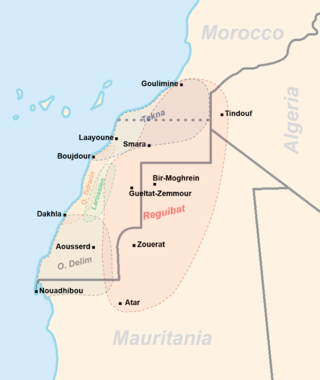
The Sahrawis, or Sahrawi people, are an ethnic group and nation native to the western part of the Sahara desert, which includes the Western Sahara, southern Morocco, much of Mauritania, and along the southwestern border of Algeria. They are of mixed Hassani Arab and Sanhaji Berber descent, as well as Sub-Saharan African and other indigenous populations.

Tindouf, also written Tinduf, is the westernmost province of Algeria, having a population of 58,193 as of the 2008 census. Its population in reality could be as high as 160,000 because of the Sahrawi refugee camps. Despite the barren landscape, Tindouf is a resource-rich province, with important quantities of iron ore located in the Gara Djebilet area close to the border with Mauritania. Prior to Algerian independence, the area served as a strongpoint of several tribes of the nomadic Reguibat confederation.

Mohamed Abdelaziz was the 3rd Secretary General of the Polisario Front, from 1976, and the 1st President of the Sahrawi Arab Democratic Republic from 1982, until his death in 2016.

The Reguibat is a Sahrawi tribal confederation of mixed Arab and Sanhaja Berber origins. The Reguibat speak Hassaniya Arabic, and are Arab in culture. They claim descent from Sidi Ahmed al-Reguibi, an Arab Islamic preacher from Beni Hassan who settled in Saguia el-Hamra in 1503. They also believe that they are, through him, a chorfa tribe, i.e. descendants of Muhammad. Religiously, they belong to the Maliki school of Sunni Islam. Their population in 1996 exceeded 100,000 people.
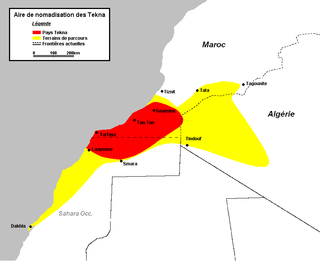
The Tekna is a semi-nomadic Sahrawi tribal confederation of mixed Arab and Lamta Sanhaja Berber origins. Its constituents today inhabit southern Morocco, northern Western Sahara and western Algeria, but traditionally with wider migration routes. Nowadays, its population is estimated to be around 709,000.

To assist in the decolonization process of the Spanish Sahara, a colony in North Africa, the United Nations General Assembly in 1975 dispatched a visiting mission to the territory and the surrounding countries, in accordance with its resolution 3292.
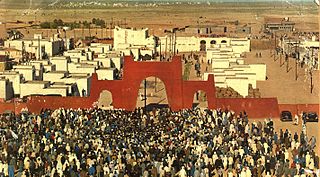
Tindouf is the main town, and a commune in Tindouf Province, Algeria, close to the Mauritanian, Western Saharan and Moroccan borders. The commune has a population of around 160,000, but the census and population estimates do not count the Sahrawi refugees, making the population as of the 2008 census 45,966, up from 25,266 in 1998, giving the town an annual population growth rate of 6.3%.
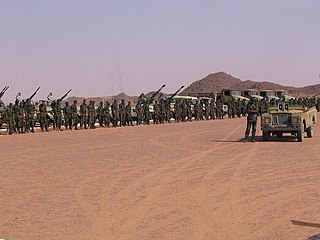
The Western Sahara conflict is an ongoing conflict between the Sahrawi Arab Democratic Republic/Polisario Front and the Kingdom of Morocco. The conflict originated from an insurgency by the Polisario Front against Spanish colonial forces from 1973 to 1975 and the subsequent Western Sahara War against Morocco between 1975 and 1991. Today the conflict is dominated by unarmed civil campaigns of the Polisario Front and their self-proclaimed SADR state to gain fully recognized independence for Western Sahara.

Khalihenna Ould Errachid is a Moroccan Sahrawi politician. He is the president of the Royal Advisory Council for Saharan Affairs (CORCAS), a government body behind Morocco's proposed autonomy plan for Western Sahara.

Algerian Saharan Arabic is a variety of Arabic indigenous to and spoken predominantly in the Algerian Sahara. Its ISO 639-3 language code is "aao," and it belongs to Maghrebi Arabic.
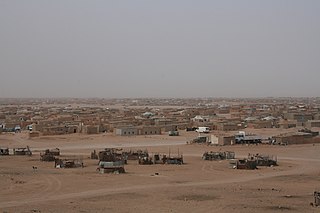
The Sahrawi refugee camps, also known as the Tindouf camps, are a collection of refugee camps set up in the Tindouf Province, Algeria in 1975–76 for Sahrawi refugees fleeing from Moroccan forces, who advanced through Western Sahara during the Western Sahara War. With most of the original refugees still living in the camps, the situation is among the most protracted in the world.

The Western Sahara War was an armed struggle between the Sahrawi indigenous Polisario Front and Morocco from 1975 to 1991, being the most significant phase of the Western Sahara conflict. The conflict erupted after the withdrawal of Spain from the Spanish Sahara in accordance with the Madrid Accords, by which it transferred administrative control of the territory to Morocco and Mauritania, but not sovereignty. In late 1975, the Moroccan government organized the Green March of some 350,000 Moroccan citizens, escorted by around 20,000 troops, who entered Western Sahara, trying to establish a Moroccan presence. While at first met with just minor resistance by the Polisario Front, Morocco later engaged a long period of guerrilla warfare with the Sahrawi nationalists. During the late 1970s, the Polisario Front, desiring to establish an independent state in the territory, attempted to fight both Mauritania and Morocco. In 1979, Mauritania withdrew from the conflict after signing a peace treaty with the Polisario Front. The war continued in low intensity throughout the 1980s, though Morocco made several attempts to take the upper hand in 1989–1991. A cease-fire agreement was finally reached between the Polisario Front and Morocco in September 1991. Some sources put the final death toll between 10,000 and 20,000 people.

Sahrawi nationality law is the law of the Sahrawi Arab Democratic Republic's (SADR) governing nationality and citizenship. The SADR is a partially recognized state which claims sovereignty over the entire territory of Western Sahara, but only administers part of it. The SADR also administers Sahrawi refugee camps.
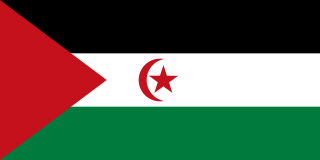
The following outline is provided as an overview of and topical guide to the Sahrawi Arab Democratic Republic:
Sahrawi refugees refers to the refugees of the Western Sahara War (1975–1991) and their descendants, who are still mostly populating the Sahrawi refugee camps in Tindouf, Algeria.
The First Battle of Amgala was fought between 27 and 29 January 1976 around the oasis of Amgala, Western Sahara, about 260 kilometres (160 mi) west of the border with Algeria. Units from the Algerian Army were attacked by units from the Royal Moroccan Armed Forces on the night of 27 January. The Algerians withdrew after fighting for 36 hours. However, the retaliation came fairly soon, between 13 and 15 February 1976 Polisario units defeated Moroccan troops in the second Battle of Amgala.

The Sahrawi Arab Democratic Republic, also known as the Sahrawi Republic and Western Sahara, is a partially recognized state, recognised by 46 UN member states and South Ossetia, located in the western Maghreb, which claims the non-self-governing territory of Western Sahara, but controls only the easternmost one-fifth of that territory. Between 1884 and 1975, Western Sahara was known as Spanish Sahara, a Spanish colony. The SADR is one of the two African states in which Spanish is a significant language, the other being Equatorial Guinea.
References
- 1 2 Gaudio, Attilio (1993-01-01). Les populations du Sahara occidental: histoire, vie et culture (in French). KARTHALA Editions. ISBN 9782865374113.
- ↑ Coppolani, Xavier (1999-09-01). MAURITANIE SAHARIENNE (NOVEMBRE 1903 A MAI 1904): suivi de L'opposition des traitants du Sénégal à l'action de Coppolani (par Geneviève Désiré-Vuillemin) (in French). Editions L'Harmattan. ISBN 9782296394582.
- 1 2 Barth, Heinrich (1859). Travels and Discoveries in North and Central Africa - Volume 3. Google books. p. 715.
{{cite book}}: CS1 maint: location missing publisher (link) - ↑ (in French) Attilio Gaudio, Populations du Sahara occidental : histoire, vie et culture, Karthala éditions, 1993 ( ISBN 9782865374113)